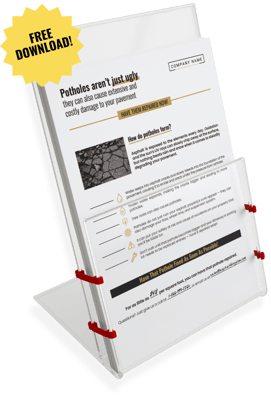Asphalt cracks and gaps can develop all over an asphalt surface. It’s more common, however, on sections where joints and seams meet, such as where asphalt edges meet the street, concrete curb, garage floor, or house foundation.
There are many possible causes of cracking, such as exposure to the weather and natural elements, freeze-thaw cycles in cold-weather locations, vehicle damage, and incorrect installation. If not filled and sealed in a timely manner, these cracks allow moisture from rain, melted snow or runoff from garden hoses to penetrate the sub-grade, as well as the foundation or basement walls, causing them to grow weak and compound the damage.
FREE DOWNLOAD!

Get Work All Year Long:
Add Pothole Repair To Your Business
Table of Contents
Some homeowners use water-based, liquid crackfiller from a local hardware store, however, this is just a temporary fix. In only a few months, the sealant will start chipping off or coming loose since the binding agents aren’t sufficient. This option is acceptable as long as there is a long-term repair scheduled shortly, such as resurfacing or repaving.
The best way to prevent cracks from developing further and causing more extensive damage is to fill them with either an asphalt patch repair or melted professional-grade rubberized crack filler, depending on the depth of the cracks.
Here’s how to repair cracks between asphalt and concrete seams and joints:
- Check the weather. Ensure that no rain is in the forecast for 48 hours after filling the cracks. Ideal ambient temperature when scheduling crack repairs should be 40⁰F, however, crack filling can still be done at lower temperatures, as long as the crack is heated to 40⁰F or 50⁰F or higher. Professional contractors usually use a torch or heat lance to heat up the cracks.
- Prep the cracks. Clean the cracks by removing any vegetation, loose debris and aggregates. Siphon or drain off any standing water. Use a sturdy bristle broom or gas-powered debris blower to remove fine particles. You can choose to power wash cracks, however, they should dry completely before filling the cracks to ensure that the crackfill will bond properly. If you prefer to get the job done like a pro, use a professional-grade sidewalk edger specifically designed to clean cracks between asphalt and concrete.
- Filling shallow cracks. For cracks that are ½” or shallower, homeowners can rent a crackfill melter from a local equipment rental shop to heat and melt rubberized hot-pour crackfiller. Then, transfer the melted material into a metal pour pot for easy and smooth application over the cracks.
For asphalt maintenance contractors, we recommend that you use a proper push melter applicator such as the RY10 Pro, to ensure professional results and customer satisfaction for every job. The RY10 Pro and half-pallet crackfill combo is a great investment that offers considerable profit.
- Patching deep cracks. For cracks that are 1” to 4” deep, use cold asphalt patch. For cracks up to 2" deep, scoop the product directly into the prepped cracks using a hand shovel, trowel or putty knife. Add enough material so it is slightly above the surface of the pavement. Tamp down until compact using a handheld tamper with metal head, which can be rented from tool rental shops.
If the cracks are more than 2" deep, fill them with coarse sand or crushed gravel first to create a base. Add gravel or sand into the gap until it reaches about 2” below the rim and spread evenly. Add the cold asphalt patch until it is slightly over the rim of the gap and tamp down until compact. For large areas, use a vibrating plate compactor for an even and professional output. - Curing. Allow repaired areas to cure between 24 to 48 hours to prevent tracking when driving over the crackfill or patch. You will know that the material is completely set when it is no longer tacky to the touch. The products will set faster in warmer weather.
Preventing cracks from forming or repairing those that are starting to show is better than having to spend thousands on major repairs. We encourage homeowners, property owners, and managers to inspect the surroundings of properties on a regular basis. This is how you spot potential problems before they get worse. If you are a homeowner and you feel that you are unable to do the repairs yourself, it is always best to seek professional help to avoid further damaging your property.
Need advice about how to maintain your asphalt? Contact our experts toll-free at 1-866-399-5562 for free, helpful advice.








-2.jpg)
-1.jpg)